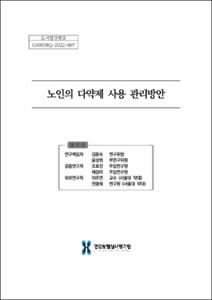노인의 다약제 사용 관리방안
- Type
- Research report
- Issued Date
- 2022-01
- Keyword
- polypharmacy; drug-related problem(DRP); medication related harm(MRH); HIRA(Health Insurance Review & Assessment Service); health insurance claim data
- Abstract
- South Korea is one of the most rapidly aging countries. Compared to other age groups, elderly use medical services more frequently and have higher rates of complex chronic diseases. Thus, they are more likely to routinely visit multiple medical institutions simultaneously and are thus more vulnerable to drug-related problems such as polypharmacy, the use of inappropriate medications, and adverse drug reactions.
The problems associated with polypharmacy include a decrease in patient compliance and an increased likelihood of drug-drug interactions and adverse drug reactions, which thereby increase the risk of hospitalization and additional medical expenses. Even when physicians and patients decide to use a medication for treatment purposes, the use of multiple drugs could eventually negatively affect the patient’s health; thus, polypharmacy is an important issue to consider in the context of elderly health.
Data for the analysis were obtained from an electronic database, in which expense claims from medical institutions that have been reviewed and reimbursed by the National Health Insurance Service (NHIS) are recorded. The study population was composed of elderly aged 65 years or older. Polypharmacy was defined as the use of ≥5 medications, and hyper-polypharmacy was defined as the use of ≥10 medications, and we examined them over periods of ≥90 days and ≥180 days during the 1-year. In order to understand the scale of drug-related problmes in the elderly and to evaluate the causality of drug-related harm, medical recores were examined for some hospitals.
Among 7,358,953 patients, 47.8% and 36.9% took 5 or more medications per day for 90 days or more and 180 days or more, respectively. Many patients simultaneously took medications with different ingredients over a long period of time. In total, 17.1% of patients took 5 or more medications per day for 330 days or more, and 11.9% and 7.1% of patients took 10 or more medications per day for 90 days or more and 180 days or more, respectively. After adjusting for multiple significant variables, Polypharmacy patients were 1.2~1.8 times more likely to be hospitalized or visit the emergency room and 1.6~2.8 times more likely to die than non-polypharmacy patients.
According to the analysis on treatment data from some hospitals, 857 out of 6,000 patients (14.3%) were found to have suffered medication related harm (MRH), and 76.0% of the 857 cases were preventable. The risk factors of MRH included anticoagulant drug, P2Y12 inhibitor, traditional NSAIDs without PPI cotherapy, antipsychotics, benzodiazepines, insulin, diuretics, and 2 or more strong anticholiergic drugs.
The results indicate that there is a need for management measures on polypharmacy for the elderly that factor in behaviors of both patients and service providers, such as information sharing with health professionals who use polpharmacy on elderly patients, production of QA criteria on polypharmacy use. In addition, continued research is required to optimize drug and medication use that assess polypharmacy comprehensively in diverse aspects.
- Publisher
- 건강보험심사평가원
- Alternative Title
- Intervention strategies to improve the polypharmacy for older people
- Table Of Contents
- 요 약 ----------------------------- i
제1장 서 론 ----------------------------- 1
1. 연구 배경 및 필요성 ----------------------------- 1
2. 연구 목적 ----------------------------- 5
3. 연구 내용 ----------------------------- 5
제2장 국내외 관련 문헌고찰 ----------------------------- 7
1. 노인의 다약제 사용 정의 및 문제점 ----------------------------- 7
2. 약물관련 문제와 투약관련 위해 평가 ----------------------------- 30
3. 노인의 다약제 사용 관련 국내 현황 ----------------------------- 37
4. 다약제 사용 감소방안 ----------------------------- 46
제3장 노인의 다약제 사용 현황 및 건강결과 분석 ----------------------------- 62
1. 노인의 연도별 의료이용 및 다약제 사용 현황 ----------------------------- 63
2. 노인 환자 코호트 구축 및 다약제 사용 현황 ----------------------------- 69
3. 노인의 다약제 사용으로 인한 건강결과 평가 ----------------------------- 101
제4장 병원 진료기록 활용 노인 투약관련 위해 조사 ----------------------------- 124
1. 조사 대상 및 방법 ----------------------------- 124
2. 건강위해 위험도 평가자료 수집 결과 ----------------------------- 127
3. 위험도 평가 도구 개발 ----------------------------- 145
4. 소결 ----------------------------- 148
제5장 고찰 및 결론 ----------------------------- 152
1. 연구결과 고찰 ----------------------------- 152
2. 한계점 고찰 ----------------------------- 154
3. 안전한 의약품 사용을 위한 노인 다약제 사용 관리방안 제안 ----------------------------- 155
참고문헌 ----------------------------- 160
ABSTRACT -----------------------------170
부 록 ----------------------------- 172
- Publisher
- 건강보험심사평가원
- Location
- KOR
- Citation
- 김동숙 et al. (202201). 노인의 다약제 사용 관리방안.
- 파일 목록
-
-
Download
 노인의 다약제 사용 관리방안.pdf
기타 데이터 / 11.21 MB / Adobe PDF
노인의 다약제 사용 관리방안.pdf
기타 데이터 / 11.21 MB / Adobe PDF
-
Items in Repository are protected by copyright, with all rights reserved, unless otherwise indicated.